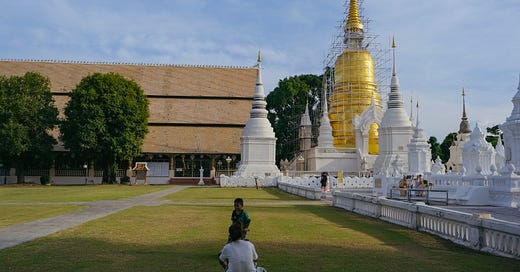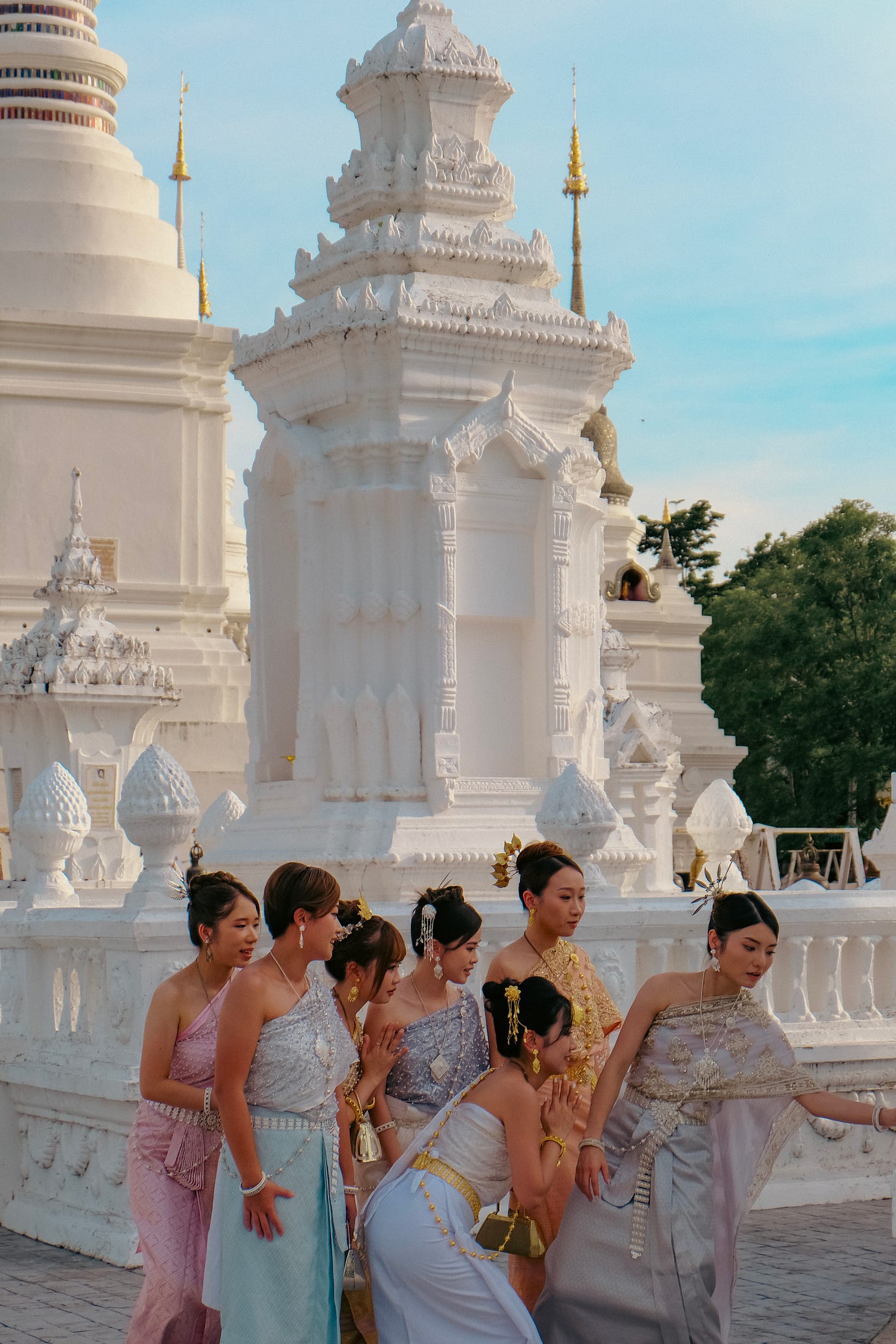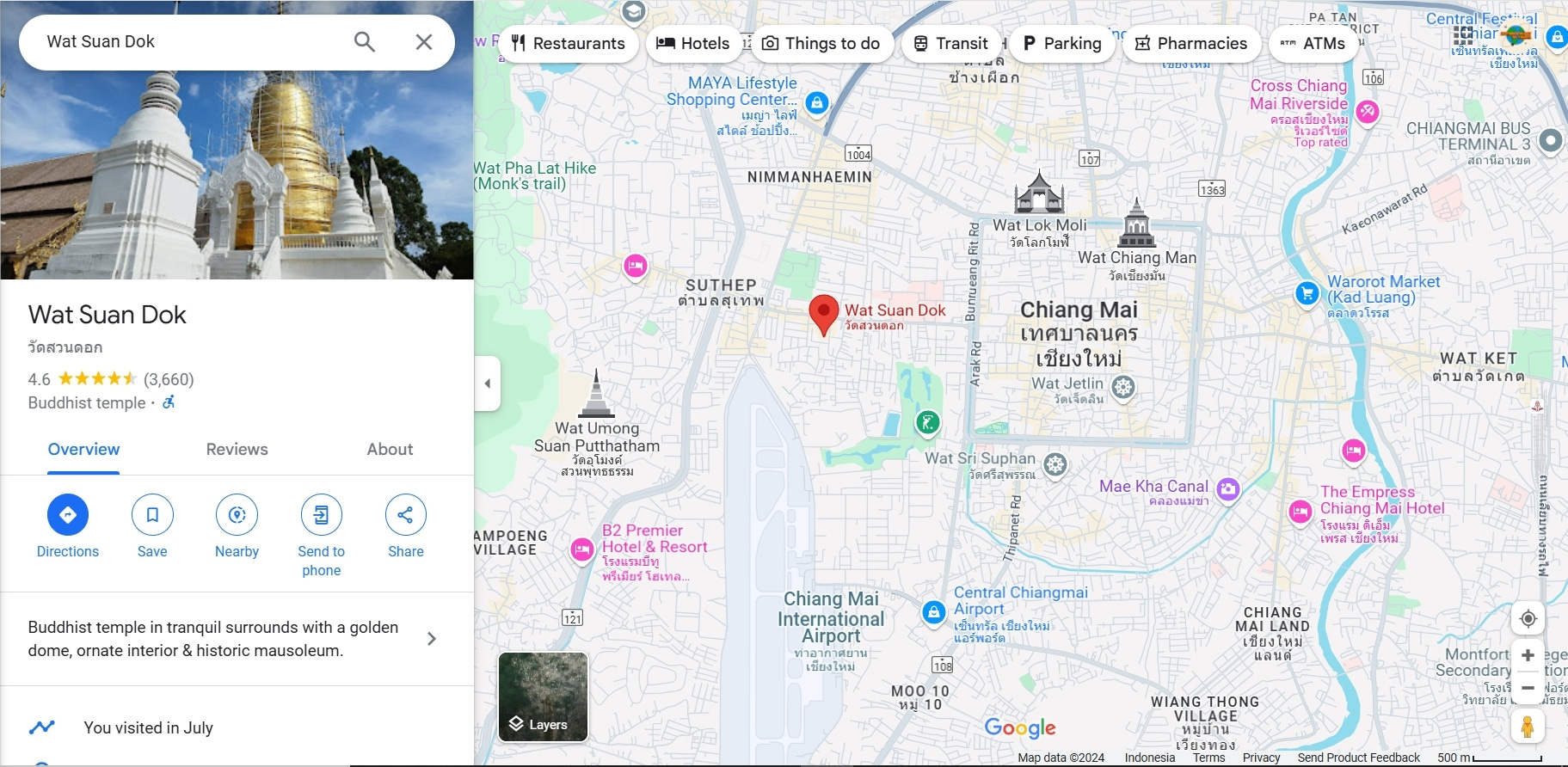Inside a Chiang Mai Native’s Favourite Temple – a Hidden Gem Even to Locals.
Exploring the marvellously unique temple of Wat Suan Dok and its unsuspecting Sri Lankan history.
By Tian Franklin, co-founder of The Anthropology of Travel
Contents
Chiang Mai, my hometown.
What you can expect to see at Wat Suan Dok.
Wat Suan Dok’s Prophetic Significance and Intriguing Sri Lankan History.
How to get here.
Chiang Mai, my dearest, beloved hometown. Some call it The Rose of The North, named so because of its stunning, holy beauty, with gold-wrapped temples perched on hills that rise and fall like gentle breaths around the city. This sleepy place is actually the second largest city in Thailand, with its own cosmopolitan pulse. Yet, walking its streets, you see an entirely different story. You’ll find humble houses nestled by rice fields, street-side food stalls with corrugated roofs, their smoke and steam from satay grills and bubbling khao soi filling the air. Listen close, and you’ll hear the distant chants of monks, the soft echoes of gongs reverberating around shops and ancient chedis. Anthony Bourdain once described visiting Chiang Mai as “discovering a colour I never knew existed before”. Being here is like Dorothy stepping into the Land of Oz. Everything explodes into colour.
The city is a world of dreams to discover. I grew up here. I lived, I experienced, and I became the person I am today in Chiang Mai. Yet, every time I come back it is like stepping into a completely new world, full of new places to explore. Each time, I find myself with a newfound appreciation for my hometown; as I grow and change, the city also changes around me, each layer being revealed in its own time.
I recently spent three months here, and I found myself drawn to one temple which I kept coming back to. Wat Suan Dok. There, in the tranquil closing hours of the afternoon, I basked in its peaceful open space, beautiful shrines, and resigned myself to the wondrous sounds of the chanting monks from the assembly hall. I hope that someday, you may also have the chance to bask in the splendour of Wat Suan Dok, a place which even locals seldom come to.
What you can expect to see at Wat Suan Dok
Wat Suan Dok translates to “flower garden temple”, named so because it is built around the site of what was once the royal flower garden of the Lanna Thai Kingdom (1292-1775), in which Chiang Mai was its capital for centuries.
Upon entering through its beautiful, whitewashed gates, you are greeted by a sense of grandeur unique for Thailand’s temples. The entrance is adorned with intricately carved Lanna patterns, sculpted by hand in blissful symmetry. Three chedis, or stupas, tower above the entrances, crowned with golden cho fahs. These ornaments symbolise the enlightenment of Buddha, their spires pointing upwards to bridge a connection between the earthly realm and the heavens.
The entrance opens to a verdant garden of luscious green grass, a rare find in the tropics. In cooler evenings, families come with their children to bask in the peaceful air. But the true focal point is the mesmerising chedi, distinct for simplistic elegance and imposing height of 48 metres. Its golden surface shimmers against the sky, and before it lies a courtyard paved with white stone and marble, dotted with smaller chedis. These chedis are in fact shrines that hold the ashes of Lanna royals and revered monks, making it no wonder why Wat Suan Dok encapsulates such impressive grandeur.
On the far side of the garden next to the towering chedi, lies the sala kan prian, or assembly prayer hall. It is an impressive structure, being the largest prayer hall in Chiang Mai. Vast and open, it lacks walls, supported only by red teak pillars. During evening prayer at the purple-hued hours of day, the awe-inspiring chants of dozens of monks echo around the temple grounds in utterly enthralling harmony.
A towering golden Buddha gleams in the heart of the sermon hall meditating with tranquil authority, illuminated by the gentle interplay of light and shadow. Behind him sits a second Buddha facing away, grounding the hall in a spiritual symmetry. The grandeur of the sala kan prian is magnified by its richly decorated pillars, patterned in deep blue and adorned with intricate golden motifs. These patterns gracefully twist upwards, forming delicate arabesques in elegant symmetry. Above, the ceiling’s golden latticework mirrors the detail below. The entire hall feels almost enchanted—radiant with holiness and gilded in subtle opulence.
Wat Suan Dok’s Prophetic Significance and Intriguing Sri Lankan History
As the legend goes, in the 1360s, the renowned monk Phra Sumana Thera from the neighbouring Sukhothai kingdom had a vision of an ancient, buried relic of Buddha whilst staying at Wat Phra Yuen in Lamphun. He had been invited there by King Gue Na of the Lanna Kingdom to rejuvenate Buddhism in the region. Compelled to find the location of his vision in real life, he dug at the site, miraculously discovering the relic. It was a miracle that could surely rekindle the populations’ faith. He proudly presented the relic to the king, who declared it needed to be housed in a dedicated temple. Thus, Wat Suan Dok was constructed, becoming one of Chiang Mai’s most significant holy sites. To this day, many believe that the relic is still encased deep within the golden chedi.
The Sri Lankan influence at Wat Suan Dok comes from Sumana Thera’s connection to the Sri Lankan lineage of Theravada Buddhism. In the 14th century, Sri Lankan Theravada Buddhism held significant influence over much of Southeast Asia. Sumana Thera was part of this Sri Lankan lineage, which had been introduced to the Sukhothai kingdom through previous missionaries and monks. The Sri Lankan influences seen at Wat Suan Dok are a centuries-old homage to Sumana Thera and his pivotal Theravada mission to northern Thailand which recaptured the devotion of the Lanna people.
The main chedi, wrapped in gold, is subtly different to those commonly found in Thailand. Its rounded, bell-like dome shape, much smoother and simple than Thai stupas, evokes a sense of stoic elegance. Likewise, its minimal ornamentation compared to the often highly intricate patterns of Thai chedis reflects Sri Lankan design which focuses more on shape and symmetry. In the prayer hall, the tall, meditating buddha has individually formed toes on its feet – something uncommon for traditional Thai design. Together these symbolise Chiang Mai’s ancient respect for Theravada Buddhism, which deeply influenced religious practices in the region.
Throughout the centuries, the monuments of Wat Suan Dok have been renovated and restored, but the chedi remains the original construction. Even more impressive, the walls of the temples were fortifications for a Lawa settlement which predated even Chiang Mai itself. You may still notice certain earthworks which show glimmers of this history if you look very hard at the outer reaches of the former settlement, which was only engulfed by Chiang Mai as recently as the 70s. However, it had been deserted for decades before that, evidential in a British diplomat’s visit to the city in 1886 where he wrote of visiting this “deserted garden” that was alleged by “some of the residents” to have once been a thriving settlement.

Thanks for reading The Anthropology of Travel! We are a travel couple building a business aiming to rethink travel for the modern traveller thirsty for real adventure built on cultural lessons, education, and community engagement. Let’s do more than just sightsee. We truly have big ideas planned! If you see the value in what we are doing, please kindly consider donating to us - it would help a lot. Regardless, I am eternally thankful that you read until the end - Tian from the AoT.
How to get to my favourite temple in Chiang Mai
Wat Suan Dok can be found on the south side of Nimmanhaemin along Suthep Road at 139 Suthep Rd, Tambon Su Thep, Mueang Chiang Mai District, Chiang Mai 50200, Thailand.
The Anthropology of Travel is an alternate travel business bringing a new philosophy to travel. It was founded by travelling couple Tian Franklin and Caitlin Denton, who quit their jobs in May 2024 to pursue this project. The Anthropology of Travel aims to rethink how we travel by emphasising cultural connections and lessons, and slow travel concerned with education, society and environment that may encourage individual growth and collective action in tackling global issues.













Thanks to your recommendation we visited this beautiful temple today - serene and peaceful. Thank you for sharing 🙏